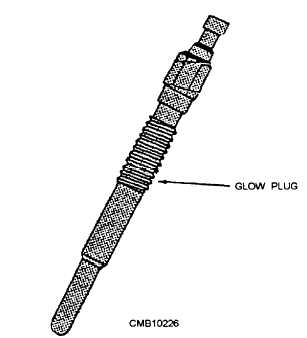COLD WEATHER STARTING
LEARNING OBJECTIVE: Identify the different types of cold weather starting aids.
Diesel fuel evaporates much slower than gasoline and requires more heat to cause combustion in the cylinder of the engine. For this reason, preheating devices and starting aids are used on diesel engines. These devices and starting aids either heat the air before it is drawn into the cylinder or allow combustion at a lower temperature than during normal engine operation.
GLOW PLUGS
The purpose of a glow plug is to beat up the air that is drawn into the precombustion chamber to assist starting, especially in cold weather. Glow plugs are common on precombustion chamber engines, but not on direct injection diesels because they use shaped piston crowns that produce a very effective turbulence to the air in the cylinder. Direct injection engines also have less immediate heat loss to the surrounding cylinder area than in a precombustion engine and generally have a higher injection spray-in pressure.
A glow plug is used for each cylinder located just below the injection nozzle and threaded into the cylinder head (fig. 5-43). The inner tip of the glow plug extends into the precombustion chamber. The glow plugs may be turned on using the ignition switch with

Figure 5-43. - Typcial diesel glow plug.
the length of time being controlled from an electronic module. On some older vehicles and construction equipment, glow plugs are operated by manually depressing a switch or button for 15 to 30 seconds. During colder weather, the system may have to be cycled more than once to start the engine.
Glow plugs are not complicated and are easy to test. Disconnect the wire going to the glow plug and use a multimeter to read the ohms resistance of the glow plug. Specifications for different glow plugs vary according to the manufacturer. Be sure and check the manufacturer's service manual for the correct ohms resistance value.
MANIFOLD FLAME HEATER
The manifold flame heater (fig. 5-44) is another type of cold starting system found on diesel engines. This system is composed of a housing, spark plug, flow control nozzle, and two solenoid control valves. This system operates as follows:
1. The flame heater ignition unit energizes the spark plug.
2. The nozzle sprays fuel under pressure into the intake manifold assembly.
3. The fuel vapor is ignited by the spark plug and burns in the intake manifold. The heat from this fire warms the air before it enters the combustion chamber.
The flame fuel pump assembly is a rotary type, driven by an enclosed electric motor. The fuel pump receives fuel from the vehicle fuel tank through the supply pump of the vehicle and delivers it to the spray nozzle. The on/off switch, located on the instrument panel, energizes the pump.
The intake manifold flame heater system has a filter to remove impurities from the fuel before it reaches the nozzle.
The two fuel solenoid valves are energized (open) whenever the flame heater system is activated. The valves ensure that fuel is delivered only when the system is operating. These valves stop the flow of fuel the instant that the engine or heater is shut down.
NOTE When troubleshooting or repairing these units, you should consult the manufacturer's service manual.
Continue Reading